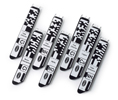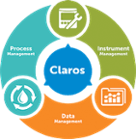|
require a minimum of 0.2 mg/L free chlorine or 0.5 mg/L total chlorine (monochloramine) throughout the distribution systems. Monitoring is also done at storage tanks and pump stations to study mixing
MORE DETAILS
|
2023-03 |
|
waters were tested separately. Find the right testing solution Monochloramine Monitor for monochloramine when one of the blended source waters is a chloraminated treated water. The monochloramine will most likely be consumed by the chlorine demand of the surface water. As the
MORE DETAILS
|
2020-12 |
|
disinfects drinking water by adding chlorine and ammonia to achieve a residual of monochloramine. Chloramination is favored for disinfection when there is a need to reduce the risk of disinfection byproducts (DBPs
MORE DETAILS
|
2023-03 |
|
security violations. Key Parameters Iron Turbidity Coliforms & Heterotrophic Plate Count (HPC) pH Total Chlorine Free Chlorine Monochloramine Free Ammonia Manganese Application Articles Water Authority Ensures
MORE DETAILS
|
2017-02 |
|
Disinfectants Application Articles Nitrification Control with Monochloramine and Free Ammonia Testing Discovering the Unexpected in Disinfection Applications Chlorine Chemistry Explained
MORE DETAILS
|
2017-02 |
|
Copper* EPA Approved Total Ammonia Free Ammonia Combined Free and Total Ammonia** Monochloramine Nitrite High Range Total Alkalinity Low Range Total Alkalinity Low Range Hardness High Range Hardness Low Range
MORE DETAILS
|
2022-06 |
|
monochloramine. Find the right testing solution Select the attributes below to find the right chlorination product for you. Compare our different
MORE DETAILS
|
2022-06 |
|
• Orbisphere K1100/K1200 Oxygen Sensors • Oxygen (LDO) Sensor • 5500 sc Ammonia Monochloramine Analyzer • 3700 Analog Inductive Conductivity Sensors • 3400 Digital Contacting Conductivity Sensors
MORE DETAILS
|
2023-09 |
|
Available Parameters Ammonia Monochloramine†, Ammonium, Conductivity*, Dissolved Oxygen, Nitrate, Organics*, ORP*, Orthophosphate, pH
MORE DETAILS
|
2023-02 |
|
gas 2 Strong, inexpensive High DBP, safety/ security issues Strong, inexpensive Taste and odor (T&O), DBP, safety issues Monochloramine Less DBP Cost, process control Longer living, less DBP Nitrification, T
MORE DETAILS
|
2020-12 |
|
Complex Method 8169 Molybdenum, Molybdate for Water Monochloramine for Water and Wastewater Monochloramine; Nitrogen, Free Ammonia >>Back to top N Nickel 1-(2-Pyridylazo)-2-Napthol (PAN) Method 8150 Nickel
MORE DETAILS
|
2021-06 |
|
). Systems that use monochloramine as measurable residual in their distribution network also track alkalinity. A consumption of alkalinity can
MORE DETAILS
|
2023-03 |
|
). Shop Now 5500sc Ammonia Monochloramine Analyzer The 5500sc Ammonia Monochloramine Analyzer provides continuous monitoring, giving you
MORE DETAILS
|
2021-04 |
|
Sensor Lab Total Chlorine Process: CL17 Lab Monochloramine Process: 5500sc Ammonia Monochloramine Analyzer Lab: n/a Process Controllers SC4500 Controller SC1000 Controller Claros Mobile Sensor Management
MORE DETAILS
|
2024-03 |
|
are used to disinfect water . During chloramination, chlorine and ammonia are added to water to form monochloramine. The portion of ammonia that has not combined with chlorine is called free ammonia, and exists
MORE DETAILS
|
2020-11 |





